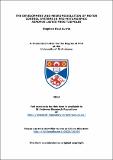Files in this item
The development and neuromodulation of motor control systems in pro-metamorphic Xenopus laevis frog tadpoles
Item metadata
| dc.contributor.advisor | Sillar, Keith T. (Keith Thomas) | |
| dc.contributor.author | Currie, Stephen Paul | |
| dc.coverage.spatial | xiv, 315 p. | en_US |
| dc.date.accessioned | 2017-01-30T12:59:04Z | |
| dc.date.available | 2017-01-30T12:59:04Z | |
| dc.date.issued | 2014 | |
| dc.identifier.uri | https://hdl.handle.net/10023/10199 | |
| dc.description.abstract | My thesis has accomplished 3 significant contributions to neuroscience. Firstly, I have discovered a novel example of vertebrate deep-brain photoreception. Spontaneously generated fictive locomotion from the isolated nervous system of pro-metamorphic Xenopus tadpoles is sensitive to the ambient light conditions, despite input from the classical photoreceptive tissues of the retina and pineal complex being absent. The photosensitivity is found to be tuned to short wavelength UV light and is localised to a small region of the caudal diencephalon. Within this region, I have discovered a population of neurons immuno-positive for a UV-specific opsin protein, suggesting they are the means of phototransduction. This may be a hitherto overlooked mechanism linking environmental luminance to motor behaviour. Secondly, I have advanced the collective knowledge of how both nitric oxide and dopamine contribute to neuromodulation within motor control systems. Nitric oxide is shown to have an excitatory effect on the occurrence of spontaneous locomotor activity, representing a switch in its role from earlier in Xenopus development. Moreover, this excitatory effect is found to be mediated in the brainstem despite nitric oxide being shown to depolarise spinal neurons. Thirdly, I have developed a new preparation for patch-clamp recording in pro-metamorphic Xenopus tadpoles. My data suggest there are several changes to the cellular properties of neurons in the older animals compared with the embryonic tadpole; there appears to be an addition of Ih and K[sub](Ca) channels and the presence of tonically active and intrinsically rhythmogenic neurons. In addition, I have shown that at low doses dopamine acts via D2-like to hyperpolarise the membrane potential of spinal neurons, while at higher doses dopamine depolarises spinal neurons. These initial data corroborate previously reported evidence that dopamine has opposing effects on motor output via differential activation of dopamine receptor subtypes in Xenopus tadpoles. | en_US |
| dc.language.iso | en | en_US |
| dc.publisher | University of St Andrews | |
| dc.subject.lcc | QL668.E265C8 | |
| dc.subject.lcsh | Neural transmission--Regulation | en |
| dc.subject.lcsh | Xenopus laevis--Development | en |
| dc.subject.lcsh | Tadpoles--Locomotion | en |
| dc.subject.lcsh | Encephalic photoreceptors | en |
| dc.subject.lcsh | Encephalic photoreceptors | en |
| dc.title | The development and neuromodulation of motor control systems in pro-metamorphic Xenopus laevis frog tadpoles | en_US |
| dc.type | Thesis | en_US |
| dc.type.qualificationlevel | Doctoral | en_US |
| dc.type.qualificationname | PhD Doctor of Philosophy | en_US |
| dc.publisher.institution | The University of St Andrews | en_US |
This item appears in the following Collection(s)
Items in the St Andrews Research Repository are protected by copyright, with all rights reserved, unless otherwise indicated.

